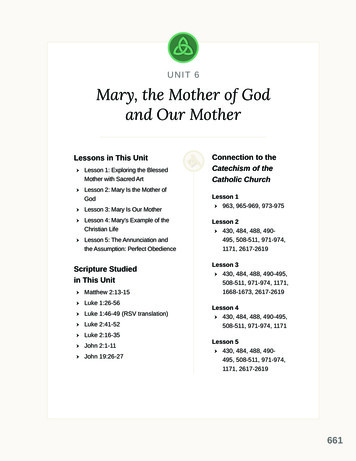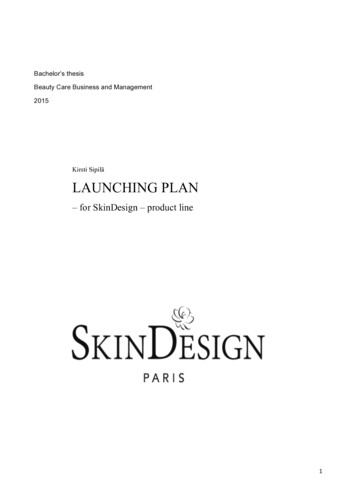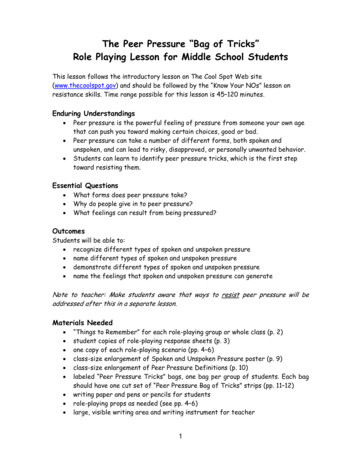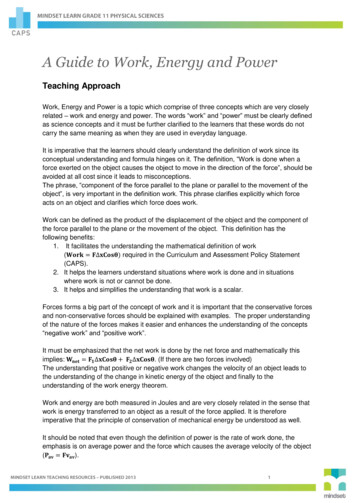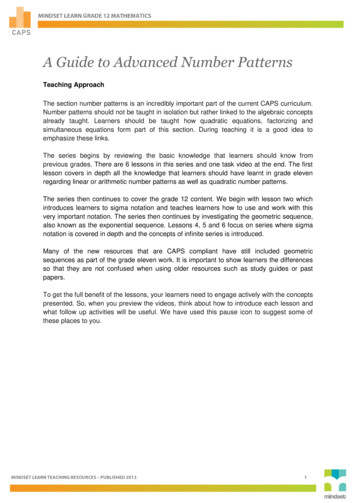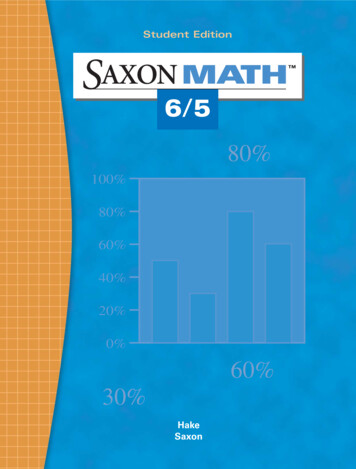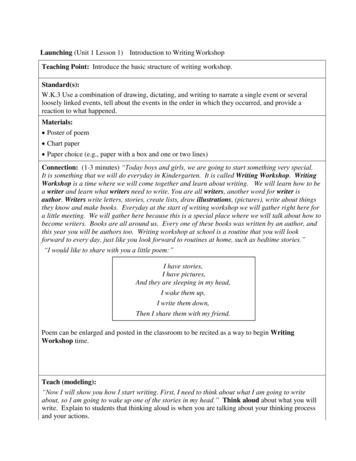
Transcription
Launching (Unit 1 Lesson 1) Introduction to Writing WorkshopTeaching Point: Introduce the basic structure of writing workshop.Standard(s):W.K.3 Use a combination of drawing, dictating, and writing to narrate a single event or severalloosely linked events, tell about the events in the order in which they occurred, and provide areaction to what happened.Materials: Poster of poem Chart paper Paper choice (e.g., paper with a box and one or two lines)Connection: (1-3 minutes) “Today boys and girls, we are going to start something very special.It is something that we will do everyday in Kindergarten. It is called Writing Workshop. WritingWorkshop is a time where we will come together and learn about writing. We will learn how to bea writer and learn what writers need to write. You are all writers, another word for writer isauthor. Writers write letters, stories, create lists, draw illustrations, (pictures), write about thingsthey know and make books. Everyday at the start of writing workshop we will gather right here fora little meeting. We will gather here because this is a special place where we will talk about how tobecome writers. Books are all around us. Every one of these books was written by an author, andthis year you will be authors too. Writing workshop at school is a routine that you will lookforward to every day, just like you look forward to routines at home, such as bedtime stories.”“I would like to share with you a little poem:”I have stories,I have pictures,And they are sleeping in my head,I wake them up,I write them down,Then I share them with my friend.Poem can be enlarged and posted in the classroom to be recited as a way to begin WritingWorkshop time.Teach (modeling):“Now I will show you how I start writing. First, I need to think about what I am going to writeabout, so I am going to wake up one of the stories in my head.” Think aloud about what you willwrite. Explain to students that thinking aloud is when you are talking about your thinking processand your actions.
“Watch me as I write.”Pick up a marker and act like you’re wondering what you could write about.“Gosh, what could I write about? Let’s see I could write about flowers, but wait! I don’t reallyknow that much about flowers. I think it’ll be easier to write about something I know a lot about.Writers often write about themselves. So, I’m going to write about myself.”“Okay, I’m going to close my eyes. I have a story in my head! I ride my bike a lot. I’m making apicture, a movie in my mind, about what happened this morning on my way to school. I’mdrawing my story, making a picture of me on my bike and how it was raining. Mud splashed allover me.”Model your thinking aloud as you sketch and label your drawing, stretching out words and writingsome sounds (bike, mud, me).It was raining. Mud splashed on my face. I looked like I had polka dots!“So, first I thought about something I did – riding my bike, and then I made a movie, a picture, inmy mind about one time that I rode my bike (this morning), and then I made a picture of my story.Finally, I wrote some words to go with my picture.”Active Engagement (guided practice):“Writers, now it is your turn to write about something that you have in your head. Close youreyes and think about which story you want to wake up in your head. Now open your eyes andturn to your neighbor and tell them what you are going to write about.”Bridge to Independent Practice:“Now it is your time to write down a story that is sleeping in your head. Writers, we will write forjust a few minutes today and I will let you know when our writing time is over” (you can use atimer/clock). Excuse the students to their tables and pass out the pencils and paper.Closure:Bring students back to the carpet with their writing. “The final part of our Writing Workshop issharing.” Reread the poem. “Now, writers, what stories did you wake up today? Turn and talkwith your neighbor.” (You could do a read around instead, or have a few students share afterpartner sharing.)Reflection:Resources & References:Poem borrowed from Denver Public Schools website.Calkins, Lucy and Mermelstein, Leah. Launching the Writing Workshop.Portland Public Schools
I have stories,I have pictures,And they are sleeping in myhead,I wake them up,I write them down,Then I share them with myfriend.
Launching (Lesson 2) Everyone is a WriterMinilesson Teaching Point:Students will build their confidence as writers regardless of their abilities.Standard(s):W.K.3 Use a combination of drawing, dictating, and writing to narrate a single event or severalloosely linked events, tell about the events in the order in which they occurred, and provide areaction to what happened.Materials: Chart paper Pencils or other writing tools Paper choice (one or two types)Connection:“Writers, yesterday I got to see your great writing. Today, I will show you other ways of writing.Then, we will practice together before you get to try different writing on your own.”Teach (modeling):NOTE: Demonstrate all types of writing on a piece of chart paper.“Let’s begin with wavy writing. Watch as I write wavy lines on my paper. I can also write zigzag.Next, I am going to practice loopy writing. Another type of writing is with ‘magic lines.’ This iswhat we use when we don’t know what to write or as a place holder. Another type of writing is thekind that looks like letters. Finally, I bet you can write some REAL letters. I will write a few foryou.”Active Engagement (guided practice):“Get out your magic writing finger and let’s practice together in the air.” Guide studentsthrough all types of writing.Bridge to Independent Practice:“Today, writers, when you write you might write in some of the ways we practiced. You might usewavy lines, loopy lines, magic lines, zig-zag lines or real alphabet letters to help you write aboutyour idea.”Closure:Gather students together with their writing. Share the types of writing they practiced today. Itcould be whole group, small group, or with a partner.
Reflection:Resources & References: (adapted from, acknowledgments)Lesson adapted from Kidwriting by Eileen Feldgus.Portland Public Schools
Launching (Lesson 3) How to Hold a PencilTeaching Point:Students will learn the correct way to hold a pencil.Standard(s):W.K.3 Use a combination of drawing, dictating, and writing to narrate a single event or severalloosely linked events, tell about the events in the order in which they occurred, and provide areaction to what happened.Materials: pencils (class set) pom-poms or cotton balls (class set) chart paper for the teacher paper choiceConnection:“We are going to do a lot of writing in Kindergarten and today we are going to learn how tohold our pencils correctly so we can do our best writing. When we do our best writing we will beable to read our writing and so will other people.”Teach (modeling):“I will show you how to hold a pencil.”Show the students how to hold the pencil without the cotton ball.“Writers, when I hold a pencil I grasp it toward the tip with my thumb and pointer finger, like Iam going to pinch something. Then, I rest the pencil on my middle finger. My ring finger andpinky are tucked under my middle finger. Now watch as I write on the paper.”Write name or various lines / scribbles.“Sometimes to help kids learn the correct pencil grasp, we use a cotton ball to help our fingersknow what to do. Watch as I grip the pencil with my thumb and pointer again. Next I will rest mypencil on my middle finger. Now, I need to put my ring finger and pinky to sleep . . . they willneed a cotton ball to lay their heads on.”Model how you hold onto the cotton ball with ring finger and pinky.Active Engagement (guided practice):“Now we will get a chance to practice holding a pencil together.”Pass out pencils and cotton balls.“First we take our pillow (cotton ball) and tuck it in with our ring and pinky fingers. Next, pick upyour pencil toward the tip with your thumb and pointer finger. Remember, it is like you arepinching something. Finally, rest the pencil on your middle finger.”Circulate around the room to help students with their grasp.“Writers, let’s practice some ‘air writing.’ Hold your pencil up in the air and practice writing yourname or draw a quick little picture.”“I have a little song to help us remember how to hold our pencil.” Teach the children how to singthis song to the tune of, “Where is Thumbkin?”
Where is pointer? Where is pointer?On the top. On the top.Ready to write. Ready to write.Start at the top. Start at the top.Where is thumbkin? Where is thumbkin?On the side. On the side.Ready to help, ready to helpYour pencil glide, your pencil glide.Bridge to Independent Practice:“As we write today, writers, I would like you to check your fingers as you hold your pencils.You may use a cotton ball to help you if you need it.” Dismiss students for writing.Closure:Before closing the writing workshop session, ask students to hold their pencils in the air, showinghow they hold them correctly. Sing the song again!Depending on time and the attention of students, you may also want to have a few students sharetheir writing pieces if some are writing letters, words and/labeling. Make this a big deal! If younotice nice details in some of the students’ drawings, you may want to share this as well.Reflection:Resources & References:Portland Public Schools
Launching (Lesson 4) “Let’s Walk to the Park” – Story SymbolsMinilesson Teaching Point:Students will learn how symbols can tell a story.Standard(s):W.K.3 Use a combination of drawing, dictating, and writing to narrate a single event or severalloosely linked events, tell about the events in the order in which they occurred, and provide areaction to what happened.Materials: Copy of “Let’s Walk to the Park” Chart paper Chart markers (red, green, and one other color) Paper for each child Red , green, and one other color crayon / marker for each child Clipboards, class setConnection:“Remember the other day when we practiced different ways to write? We practiced wavy, loopy,zigzag, and many other types of writing. Today, writers we are going to write a story using moreways of writing.”Teach (modeling):On chart paper, draw a green line down the length of the paper on the left side and a red line downthe right side.“Writers, the green line tells me where I start writing and the red line tells me where I will stopwriting. The green line is the ‘go’ line and the red line is the ‘stop’ line.Model moving a finger left to right from line to line and also demonstrating a return sweep.“I will tell you a story about coming to school today. I walked to my car (make dashed lines acrosspaper from green to red). I drove down the road and went over a bunch of bumps (make connectedarches across the paper from green to red). I went up and down some hills (big humps). Next I wasstuck in traffic and I heard a lot of horns (vertical or diagonal slash marks). I arrived at schoollate, so I went into the building quickly (a long horizontal line).”Active Engagement (guided practice):“Now we get to write a story together.” Pass out the materials. Demonstrate writing the story onchart paper with the students. “First, let’s write our green line down the left side of the paper.Now let’s write a red line down the right side of the paper. Do you remember what these lines tellus?” (You may want to collect the red and green colors at this time). “Now, let’s write our storyabout going to the park.” (See story at end of lesson.)
Bridge to Independent Practice:“When you write today, you might enjoy telling a story of an adventure you went on. Maybe itwas to the zoo. Maybe it was to the beach or to the store. You can use our crayons to help youtell your story.”Closure:Gather the students back on the carpet and share any stories that the kids wrote inthe format of this minilesson.Reflection:Resources & References: (adapted from, acknowledgments)Portland Public Schools
Let’s Walk to the Park: A Story of Symbols
Launching (Lesson 5) Using Writing FoldersMinilesson Teaching Point:Students will learn about the parts of their writing folder.Standard(s):W.K.3 Use a combination of drawing, dictating, and writing to narrate a single event or severalloosely linked events, tell about the events in the order in which they occurred, and provide areaction to what happened.Materials: Writing folder for each student (NOTE: Choose the type of writing paper that works best foryour classroom. Paper choice may change throughout the year) Pencils or other writing tools (make sure you have taught how to use them) Large version of writing folder for teacher modeling Red and green dot stickers (one of each color for each student) “I Have Stories” poem “How to Hold A Pencil” songConnection:“Yesterday we learned how to hold a pencil, today we will learn about a new tool. We will learnabout our Writing Folder. Our folder is special and has many important parts.”Teach (modeling):“Each of us will have our very own folder. Yours will look just like mine, only smaller. I want totell you about all the parts.”Point to the front cover. Talks about the title (for example, “Writing Notebook”). Point to theauthor (your name).Show the back of the folder, and the show the pockets.“It is important to remember all the parts because we want to keep our writing organized. To helpme remember where the writing I’m working on is, I will put a green dot sticker on the bottom ofthat pocket. When grown-ups drive, a green light means ‘go.’In our folders the green dotmeans that it is where I can keep working. Then there are all of the stories I’ve finished. I need toknow when to stop. When grown-ups drive, they know to stop when they see a stop sign or a redlight. I will know where to stop in my folder because I am going to put a red dot sticker on thepocket. Each day I will put my writing in my folder. I will put my new stories on the side with thegreen dot and only move them to the other side with the red dot after I have completely finished.”
Active Engagement (guided practice):“Now I would like to give you your very own Writing Folder. Together we will name the parts andplace the red and green stickers on it.” Pass out folders. “Writers, I would like you to show me thefront cover. How do you know it is the front? (It has the title and my name). Please point to thetitle. Please point to your name. Next we are going to place a green dot sticker on the first pocket.Please find the front cover again. Now open your folder. The pocket you are looking at is the firstpocket. Put your green dot on the bottom of the first pocket. Now. point to the other pocket. Wewill place a red dot sticker on the other pocket. It will also help us if we accidentally open ourfolders upside down. If we see the red dot, we will stop, and go to the other pocket.”Dismiss students to their tables with their Writing Folders.Bridge to Independent Practice:Review and recite the “I Have Stories” poem and the “How to Hold a Pencil” song to helpestablish routines and build your community of writers.“Today writers, I want you to write and put your first page in your Writing Folders. Who cantell me how you know where the front of the notebook is located?”Closure:Bring the students back to the carpet. Have students hold up their open folder with the pagethat they wrote on in the pocket with the green dot. They can give themselves a pat on theback if they put the page in the pocket that has the green dot.Reflection:Resources & References: (adapted from, acknowledgments)Portland Public Schools
Launching (Lesson 6) Using Writing Folders: Writing ExpectationsMinilesson Teaching Point: Students will learn what is expected for writing in their folders /individual papers for writing workshop.NOTE: Choose the type of writing paper or folders that works best for your classroom. Paperchoice may change throughout the year.Standard(s):W.K.3 Use a combination of drawing, dictating, and writing to narrate a single event or severalloosely linked events, tell about the events in the order in which they occurred, and provide areaction to what happened.Materials: Folders for each student Pencils or other writing tools (make sure you have taught how to use them) Large version of writing paper for teacher modeling. “I Have Stories” poem “How to Hold A Pencil” song Sticky notesConnection:“Yesterday we learned about the parts of our Writing Folders. Today we will learn how to usethis new tool our writing paper inside the folder. We will learn three things we need when wewrite. We will need to write our names, make a drawing/picture, and do some writing (words orletters).”Teach (modeling):“Let’s quickly review the parts of my folder.”Review the front, back, and the green and red dots.Deliberately show how you will write on the left side of the paper today. “The first thing I will needto do is write my name on the paper. I want to place it somewhere important, where others can seeit. I will write my name at the top of my paper.” For those students who do not know how to writetheir own name, you can model how to copy their name from a nametag, write the first letter, ortrace over name written by the teacher with a highlighter.“The next thing I want to do is draw my picture. I will use the middle part of the page to draw.”Model a simple illustration for your writing.“Finally I will need to write my words. I can either write my words under my picture/drawingor I can label my picture/drawing with words (or letters).” Model writing and reading backyour writing.“Now I want to look back at my writing and see if I have done all three things. Did I write myname at the top of the page? Did I draw my picture? Did I write words (letters) to go with mypicture?”
Active Engagement (guided practice):“Let’s pretend today that our backs are our writing paper. Find a buddy (teacher choice) andhave one person be the writer. The writer sits behind the other child and uses his/her back aspretend paper. Everyone will get a turn to be the writer. Writers. . . get your pretend pencil. Write your name at the top of your ‘paper.’ Now, draw a picture inthe middle. And finally, let’s write some words.”Buddies switch roles and repeat writing the three writing parts (name, picture, words/letters).Dismiss kids to their tables.Bridge to Independent Practice:Pass out writing materials. Review and recite the “I Have Stories” poem and the “How to Holda Pencil” song to help establish routines and build your community of writers. Help children,as needed, find the page to start on.Closure:Bring your students back to the carpet with their writing. Ask them to point to their three writingparts on their paper.“Point to your name. Point to your drawing/picture. Point to your words/letters. Give yourself apat on the back.”“The last thing we will do is learn how to use a sticky note to mark our page for the next day. I willgive each of you a sticky note that you will place on the bottom of today’s writing. This willremind you where you will begin tomorrow.”Teachers, this is intended to be set up so that students can reread their writing the next day.Reflection:Resources & References: (adapted from, acknowledgments)Portland Public Schools
Launching (Lesson 7) Left to Right / Return SweepMinilesson Teaching Point: Students will learn how to write on their paper. They will learn thatwriters write from left to right and about the “return sweep.”NOTE: You may need to revisit this lesson for the return sweep as students advance in theirwriting.Standard(s):W.K.3 Use a combination of drawing, dictating, and writing to narrate a single event or severalloosely linked events, tell about the events in the order in which they occurred, and provide areaction to what happened.Materials: Large version of writing paper for teacher modeling. Simple story idea to share with students (or adapt the idea below to fit your needs). Paper that has two lines to practice the return sweep.Connection:“Writers, today we are going to learn how to write on our papers. When we write, we want to beable to read our writing and we want other people to be able to read our writing, too. In order forus to read our writing, we have to organize our words and sentences on our paper. I know how toread books, because the authors have all written their writing in the same way. Today, we willpractice writing the way authors do so that others can read and understand our words.”Teach (modeling):Do a quick think aloud about what to write. “I want to write about my dog today. She loves to goto the dog park and play fetch. She gets lots of exercise and runs really fast. I’m making a movie inmy mind of one time when I threw the ball and she ran so fast that she slid right past the ball.”Model the steps for writing in notebooks or on paper (writing your name and drawing a picture).“First, I’m going to draw my idea.” Quickly sketch your story.“Now, I want to write my idea. When writers write, they always begin writing their idea on the leftside of the paper. I know which side is on the left by using my hands to help me. When I hold myhands straight out in front of me with my thumbs sticking out. My left hand makes a capital ‘L.’When I look at my paper, the left side is over here.” Model holding up your hands and movingthem toward the writing paper to show the left side of the page.“I will begin writing my words here.” Write the words while speaking them aloud to the students.Point out to the children that you starts at the left and work toward the right. Continue writing untilyou reach the right side. Think aloud problem solving the return sweep. “Writers, I have come tothe other edge of my paper and I still have more to write. Watch as I do a return sweep to the leftagain and finish my writing.” Possible story to write:
I took Sophie, my dog, to the park. We played fetch. I threw the ball and sheran so fast she ran right past the ball.“I want to read back what I wrote today. I will start reading on the left side. It is easier to readbecause I have written from the left to the right, and I know that when I get to the end of the line, Iwill sweep back to the left and begin reading again, just like I write.”Active Engagement (guided practice):“Before I dismiss you to write on your own, let’s pretend again that our backs are our writingpaper.Find a buddy (teacher choice) and have one person be the writer. The other personwill be the paper. Everyone will get a turn to be the writer. How will we know where to begin?”Guide the children through holding out their hands and finding the one that makes the capital ‘L’.“Now, let’s get our magic pencils and begin writing. Uh-oh . . . we have come to the end of our line,but we still have more to write. What will we do?” Model picking up your magic pencil and doing areturn sweep to the left. Buddies switch roles and repeat writing left to right and doing a returnsweep.Bridge to Independent Practice:“Before you begin writing your words today you might stop and think about where to begin.If you are not sure, try what we learned to figure out what side is the left side bylooking at your hands.I can’t wait to read all your great writing.”During writing time, if you notices that students are still uncertain where to start and which way togo, you can draw a green and red line on their paper, like what was done in the lesson “Let’s Go ToThe Park.”Closure: Bring your students back to the carpet with their writing. Ask students to point to thebeginning of their writing. Have them slide their finger under their words, moving left to right, andpossibly doing a return sweep. You may want to select a few student notebooks to share with theclass. Congratulate students for writing left to right and doing a return sweep (if possible). Tell thestudents that you were able to read their writing because they wrote just like real authors.Reflection:Resources & References: (adapted from, acknowledgments)Portland Public Schools
Launching (Lesson 8) Turn and TalkMinilesson Teaching Point:Students will learn the strategy of turn and talk.Standard(s):W.K.3 Use a combination of drawing, dictating, and writing to narrate a single event or severalloosely linked events, tell about the events in the order in which they occurred, and provide areaction to what happened.Materials: Choose a volunteer prior to the lesson and confer quickly about what is expectedTIP: You may want to assign partners if you haven’t done so yetConnection:“Writers, today we will learn a strategy that will help us plan what we will write in our writingtime. Today, I want us to learn a strategy called turn and talk. Strong writers have a plan beforethey write. Sometimes it helps us to talk about our ideas before we write.”Teach (modeling):“Writers, today we will learn how to turn and talk. I will need a student to come up and help medemonstrate to the class how we do this.”Model a think aloud about his/her topic s(he) wants to share with her /his partner. Reminder:Explain to students that their thinking should be in their heads, you are only saying it out loud sothey can hear what you are thinking.“Now we are going to turn and talk. The first thing we will do is sit knee to knee on the carpet.Look at how we are facing each other, eye to eye. Now each of us will get a chance to talk and tolisten. When the other person is talking, it is very important that you practice being a goodlistener. Now I will talk about my idea with my partner, then my partner will talk about his/heridea.”Active Engagement (guided practice):“Writers, now it is your turn to practice this new strategy. Turn to the person sitting next to you,sit knee to knee and look eye to eye (You may have to decide who starts first).” Now tell yourpartner your ideas for your story.”Trade roles.Bridge to Independent Practice:“Writers, now that we have shared our ideas, it is time for us to go and put our ideas ontopaper.”
Closure:Bring students back to the carpet and have them practice turn and talk again about what theyliked about writing today. If time, do a pop-up share.Reflection:Resources & References: (adapted from, acknowledgments): “Second GradeWriting: Units of Study,” Portland Public Schools, 2008.Portland Public Schools
Launching (Lesson 9) Accessing and Returning Writing MaterialsMinilesson Teaching Point:Introduce students to the writing materials in the classroom or writing center. Students will learnhow to independently locate, use, and take care of supplies needed for writing workshop.NOTE: This lesson may be taught over several days, explicitly modeling for each material.Standard(s):W.K.3 Use a combination of drawing, dictating, and writing to narrate a single event or severalloosely linked events, tell about the events in the order in which they occurred, and provide areaction to what happened.Materials: Varies by classroom. Some examples include:PencilsMarkersDate StampPost-itsCrayonsColored pencilsVariety of paper choicesConnection:“We know that writers have lots of ideas to write about, but they also have special materials andthey take care of them so that they will have them whenever they want to write. Today I want toteach you where to find supplies you’ll need as a writer and how to take care of them.”Teach (modeling):NOTE: Routines vary by class.)“Every writer needsto write. We keep these” (name a variety ofwriting materials and where they can be found in the classroom).“I will show you how touse and take care of, then you will get a chance to practice.”Model how to retrieve the writing tools. If you have a writing center set up with paper choice (atthis point offer only one or two types of paper) and other materials, model first getting your folder(or journal) and then going to the writing center to get paper. Afterwards, model getting a writingutensil.“Turn and talk with your neighbor about what I just did to get ready to write.”Next, model putting the materials away. “Okay, let’s pretend it’s the end of writing workshop. It’stime to clean up and then go back to the carpet for sharing. Watch me put my writing materialsaway.” Put your writing into your folder (if you are using folders), put the utensil away and cometo the carpet with your folder and sit down on your folder.“Turn and talk with your neighbor about what I just did to clean up.”
Active Engagement (guided practice):Have students practice the routine for getting writing materials.Show children how to take care of the supplies, then ask children to practice taking care of thesupplies (for example, listening for the click of the marker cap to ensure it is on).NOTE: Teachers have found it helpful to explicitly teach and have the students practice takingcare of classroom items such as scissors, glue sticks, glue bottles, books, papers, and so on.This lesson may need to be repeated several times in the beginning and then periodicallythroughout the year.“Let’s pretend that it’s the beginning of writing time and you’ve decided what to write about andyou are ready to go to your seat. What materials are you going to need for writing? When I callfor table helpers (or whatever system you have established), the helpers will quickly and quietlygather the supplies for your table. Let’s watch and see how quickly and quietly they do thisbecause, remember, we don’t want to waste a minute of our writing time together.”Demonstrate and practice the procedure you have decided upon for your classroom.Bridge to Independent Practice:Demonstrate and practice the procedure with all of the students in the class. It is importantthat everyone has the opportunity to practice the procedure.Give students an opportunity to write.Closure:Ask students to meet you at the carpet, leaving their writing and materials at their writing area.“Writers, I noticed how well you took care of our writing materials. I noticed that you .” Bespecific to reinforce the behaviors you want practiced. You may w
a writer and learn what writers need to write. You are all writers, another word for writer is author. Writers write letters, stories, create lists, draw illustrations, (pictures), write about things they know and make books. Everyday at the start of writing workshop we will gather right h

